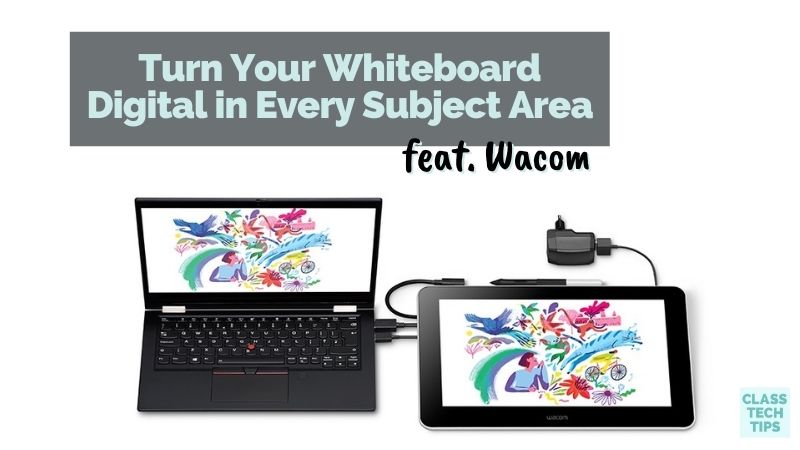How do you model ideas and empower student creators? This summer, I had the chance to take a look at two fantastic tools from Wacom. If you are looking to draw a quick visual to help students understand a concept, or want to give students space to personalize images or videos, these two tools have you covered.
In this blog post, I’ll take you through One by Wacom (tablet) and Wacom One (display). And in the video below, you can hear me talking about these tools and I share a quick demo, too. I’ve also included a few of my favorite activity ideas in this post and a shout-out to some EdTech favorites. These activities and EdTech tools pair perfectly with One by Wacom and Wacom One.
How to Turn Your Whiteboard Digital
If you haven’t heard of Wacom before, they create powerful tools for educators. As you can see in the video below, One by Wacom can be used with most pen-enabled creative software. It also works well with many popular online learning applications. One by Wacom works with PC, Mac, and most Chromebooks, too.
Wacom One is the tool you can see me using in this video (embedded below). It has a 13.3-inch screen and includes access to creative software:
- Collaboard: a space for brainstorming and representing thinking with visuals using real-time collaboration
- Explain Everything: a robust tool for creating explainer videos and tutorials
- Kami: a collaborative annotation tool
- Limnu: an online whiteboard with collaborative drawing tools for students
- Pear Deck: an interactive presentation tool that allows you to gather formative assessment data
5 Subjects to Use Digital Whiteboards
With One by Wacom (tablet) and Wacom One (display) you can turn your whiteboard digital in every subject area. Want to provide students with clear visuals as you demonstrate a concept? These have you covered for live in-person learning, distance learning, and hybrid learning environments.
Of course, you might use this as a teaching tool to model ideas live in your classroom as students watch and ask questions. Or you might use it to create videos to share with students later in the year. On this list, I’ve included some teacher creation and student creation ideas with a few examples of what this can look like in different subject areas.
Science
In a science classroom, teachers might create an explainer video, and students might sketch out ideas and brainstorm as they prepare for a science experiment. Students can use this space to record observations or use it as a collaborative tool to post ideas as they work. The ability to sketch and record their thoughts in an online space means students can upload and share their work instantly and include various media (and links) in their creations.
English Language Arts
Text annotation is nothing new, but with a digital spin there are lots of options. Teachers can model reading strategies and how to unpack a text. Your students can dive into a passage on their own or work collaboratively as they examine a piece of writing. Students can get real-time feedback from their teacher, and take interactive notes. In the quick reference guide Pam Allyn and I created for ASCD, called Engaging Students in Reading All Types of Texts, we share, “As students think critically, modeling and supporting their note-taking and annotations is essential.”
Math
Teachers and students can use One by Wacom (tablet) and Wacom One (display) to create tutorials and draw the steps to solve a problem in a math classroom. Want to change your formative assessment routine? Instead of filling in a multiple-choice answer or sharing just a sentence or two in an open-ended response, students can talk through their process as they show their work on the screen. This provides teachers with an opportunity to hear from students throughout the problem-solving process. It can also serve as a video they share with their classmates.

Social Studies
What does it look like to turn your whiteboard digital in a social studies classroom? Teachers can model ideas and draw on the screen to show off a timeline of events. They can pull up an image on the screen to highlight aspects of a primary source document. Students in a social studies classroom can use a digital space to represent information visually, too. For example, they can create an explainer video to show off what they have learned about a period in history. Alternatively, they can use a brainstorming tool to prepare for a research project.
Art
Both students and teachers can create using these tools to sketch and draw. One by Wacom and Wacom One both have a paper-like surface with natural friction. The pen paired with each device is perfect for simple and complex projects for student creators. Students using Wacom One will certainly love the Bamboo Paper app, which transforms your creative pen display into a sketchpad.
Are you ready to get started? Turn your whiteboard digital with One by Wacom (tablet) and Wacom One (display). Use these links to learn more about each one, and check out the video I made taking you through a few of the activities in this blog post!







